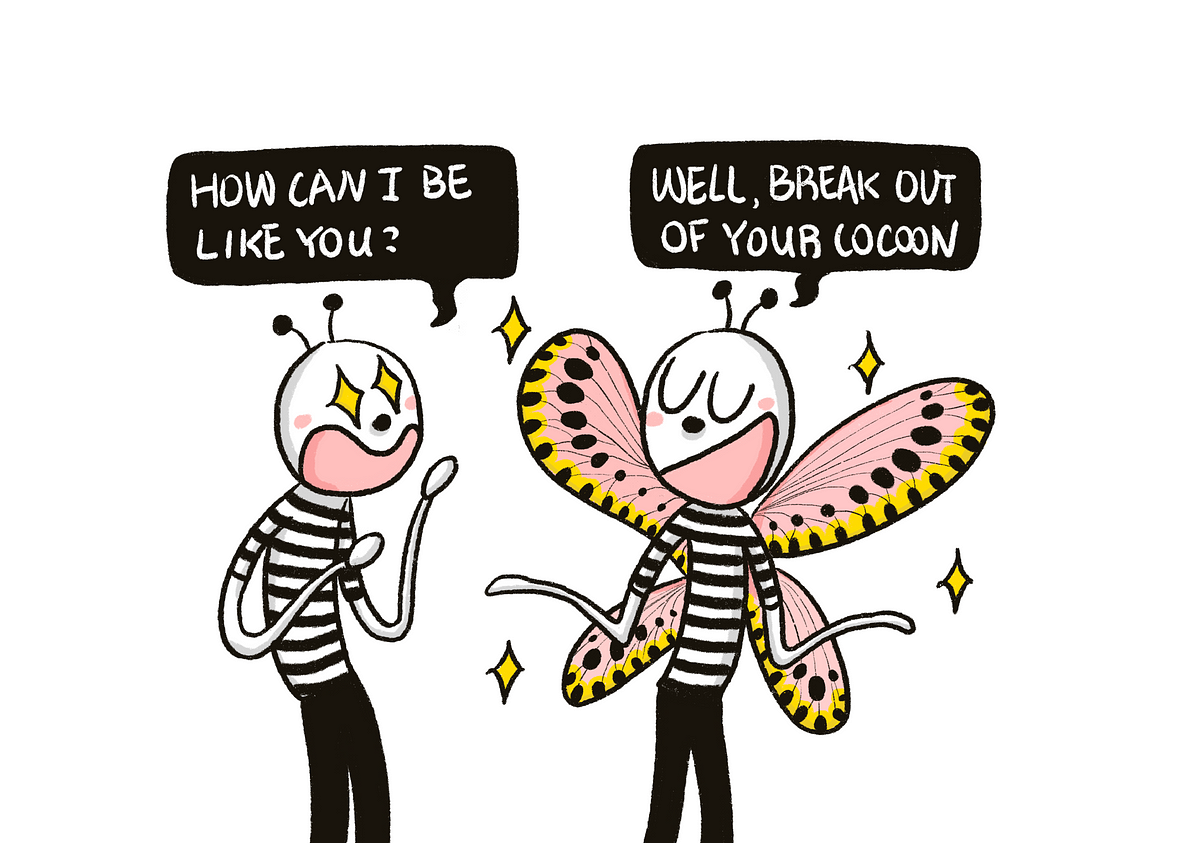Growth starts with you, drive proactively, build opinions and speak up like an owner, regardless of your fears and doubts. Strive with effort, you will make your breakthrough.
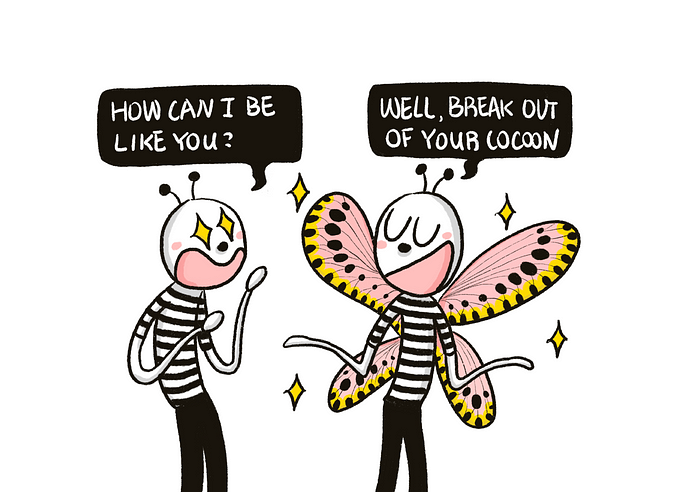
When I started at Google seven years ago, I was a base designer who worked diligently and executed designs diligently. I thought that difficult work would lead to greater opportunities. But over time, I found myself stuck in small repetitive projects. Inside me, I couldn't wait for my manager to meet me and give me bigger opportunities.
It wasn't until I made significant changes - changing teams and companies, and most importantly changing my mindset, that I realized: growth must be initiated.
A senior designer, by definition, is a thinker and an active owner. No one can give it to me.\nI had to move from an operations director to an owner, actively identifying new opportunities and voicing my opinions regardless of my fears and doubts. Since then, I have had a much faster career and personal development - becoming more confident, working on larger projects, receiving promotions, and being invited to speak at many international conferences.
Today, as I advise base designers, I often see similar hesitations in them - eager to grow but waiting for others to give them a push or permission to step up. But transitioning to a senior designer requires you to push actively and self-identify new opportunities.
Does stepping up sound scary? What if you deceive yourself? What if you can't identify new opportunities? What if others don't agree with you?
I feel you. It can feel scary. I will share my growth story and the mindset changes that helped me. I hope to make you excited (not afraid) to embark on this transformation journey. The butterfly inside you is waiting to come out ~
Here's a preview of my 5 thoughts:
- Growth will be initiated. No one can give it to you.
- To step up, become an owner, not an executor.
- Voice opinions even when you're not 100% sure.
- When challenged, be determined to understand, not to win.
- Fear and doubt will always be there, but don't let them stop you.
Defining "senior designer"
Before we proceed, let me clarify the meaning of a senior designer from a Muslim perspective in this article. I focus on a high-level change and transformation of thinking, not a detailed job title definition.

I use the term senior Muslim designer as a broad term to describe an experienced designer who:
- Plays an active role in their team's decision-making process.
- Can solve design problems independently and knows when to seek collaboration and support.
- Proposes new directions and challenges decisions when necessary.
- And much more. But in this article, I will focus on the above.
To compare, a base designer is someone:
- Receives project summaries from product managers or other potential clients.
- Executes design solutions with some support.
- Communicates design solutions to collaborators immediately.
Furthermore, for me, becoming a senior designer is not just a promotion. Promotions are external validations, but they are short-term and determined by others.
The real reward is that you are growing and achieving more as a person. You will be able to tackle more challenging issues and have a greater impact - not just design issues, but also product, business, organizational, and even industry issues. You will gain confidence and leadership skills, which will make you more successful. You will become a new you - a butterfly ~
Now, let's dive in!
1: Growth will be initiated. No one can give it to you.
When I was a fresh graduate designer, I loved being seen as reliable and hardworking. It was an honor badge to be offered more projects. I often worked on 4 out of 5 projects at the same time and voluntarily worked late nights and weekends.
After two years of hard work, I started to lose patience. I was still the most junior designer on the team. I was asked to do many projects but small projects. Once, when the design team was working on a 5-year vision project for a completely new product, I was the only designer in the team not working on it. I watched how the senior designers in my team created a big vision. It looked exciting and cool!
"Unfair! When is it my turn ?!" I thought. I also wanted to work on bigger and more strategic projects. Over a year, I felt stuck in repetitive and small projects. On one hand, I felt undervalued. On the other hand, I doubted myself. I thought, maybe I didn't have what it takes to work on bigger projects and that's why I was never given the opportunity.
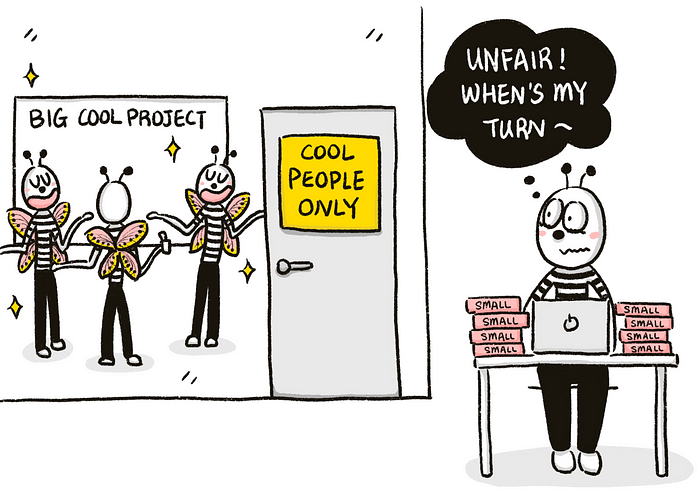
Eventually, out of frustration, I left the team and the company. After leaving Google, I took two weeks off before starting my next job at Meta. During that time, I sat down with myself and reflected on my years at Google.
When I finally was honest with myself, as much as I wanted to blame my managers for not giving me bigger opportunities, I admitted to myself that I had limited my own growth. I did well but only in what I was told to do. I reacted. I was an observer and an executor. I never asked for bigger projects or sought bigger opportunities proactively .
As I reflected, I wanted to be different in the future. I thought about what I wanted to do more in my new job: Seek new opportunities and challenges for growth, be an ambitious and confident voice my ambitions, be an owner and take action. I wrote these in a reflection document:
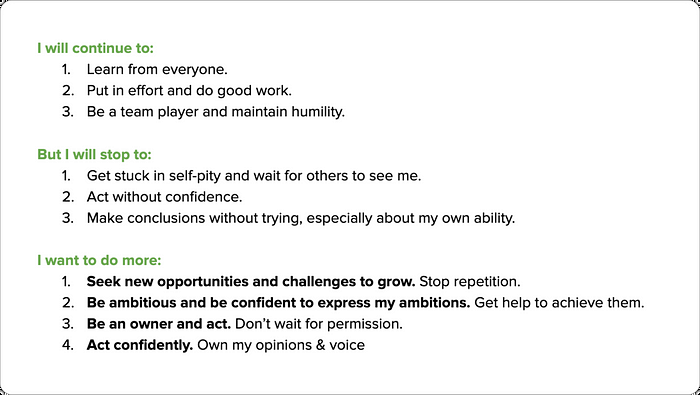
Never underestimate the power of honest reflection!
By the time I started at Meta, I was determined to be different. I went in with a more proactive mindset. Unlike my old self, who often hesitated to propose new ideas, in my third week at Meta, I proposed to do a vision project. Although not 100% confident, I knew I had seen enough vision projects at Google to at least give it a try. This time, I didn't wait for someone else to request me to do the project. I proposed it proactively because I believed it was necessary and could help the team.
Guess what?! My new manager noticed me quickly. Two months later, when it was time to execute a larger vision project, even though I was one of the newest and more junior designers in the team, my manager chose me to work on it! From there, I continued to have bigger opportunities. My first year at Meta turned out to be one of my fastest growth years. I was promoted to a senior Viking level just after a year at Meta.
What I learned is that growth will be initiated. Senior designers create their own opportunities. They don't wait for others to assign them bigger roles.
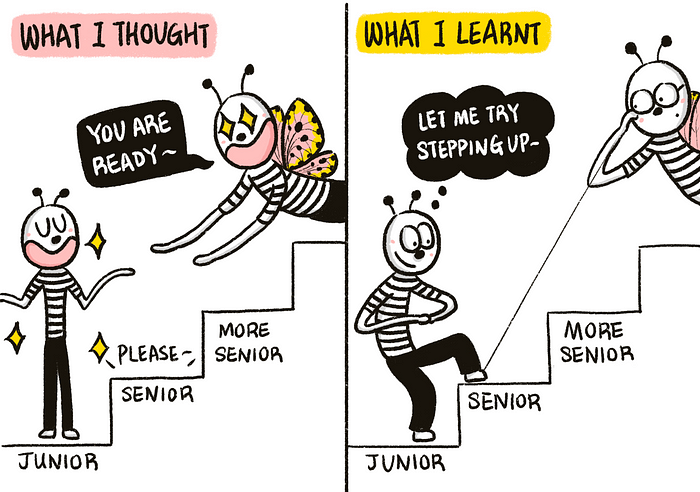
If you're a base designer wanting to work on bigger projects, don't wait for others to hand them to you. Identify them yourself. Your path up is stepping up yourself .
"But how do you step up? How do you identify bigger opportunities? You may ask. Let's move on to the next section.
2: To step up, become an owner, not an executor.
In my second year at Google, I worked with a PM who joined the team the same week as me and was also one of the youngest in the team. The similarities between us ended there. Unlike me, she quickly became the center of the team, making plans, talking to potential clients as if they were friends, and often bringing the team together for discussions and social events. In comparison, I was slow in enhancing, silent, and afraid to voice opinions. Over a year, I felt like I was living in her shadow.
At that time, I thought we were different because we were fundamentally different people. She was an extrovert, and I was an introvert. She was a PM, and I was a designer. She spoke and looked like high-level leaders, and I was a quiet Chinese working among Americans and Europeans. I thought I would never be like her - with so many impressive ideas and looking so confident. I thought I had to accept.
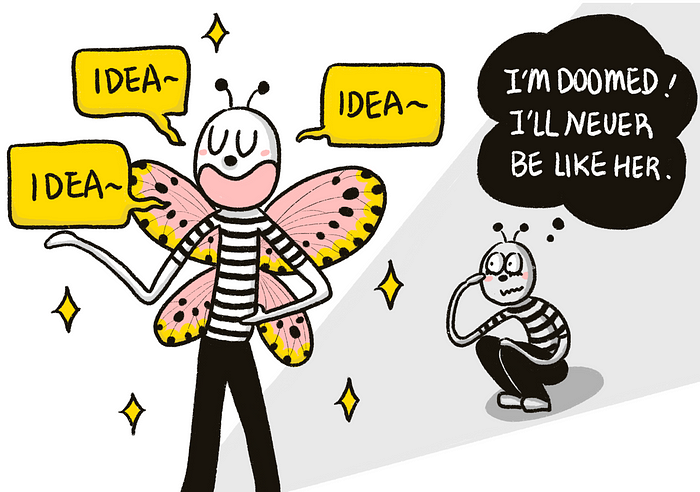
Only after leaving Google did I realize the real, fundamental difference between the PM and me: She thinks and acts like an owner , while I think and act like an executor .
As a PM, she spent time thinking about team directions and often beyond her team's scope. Her confidence was built on her taking the time to think through the big picture and form comprehensive opinions. Her focus was, what should we do for a team to succeed?
I also cared about the team, of course, but in a different way. As a base designer, I was used to taking project summaries from others, waiting for directions, and then executing them to the best of my ability. I couldn't come up with bigger ideas and strategies because I had never taken the time to think about them. My head was buried in my small scope. My focus was, How can I execute the work assigned to me the best way?
When I joined Meta, I wanted to be different. To get myself to think about the big picture, I pretended, in my mind, that I was responsible for my team's overall results. I told myself to take the time to think about what we, as a team, need to do next, even if no one will ask me about it.
As a result, I saw a significant change in my thinking and behavior. The team I joined at Meta was new and without clear team leadership. Instead of waiting for someone else to define it, I thought about what we could do next. What I thought was the team vision project I mentioned in the previous section. The Vision project helped the new team come together to form a clearer direction. It also got me noticed by my new manager, leading to bigger opportunities for me. Over time, I became more like the PM I worked with - taking more ownership and responsibility, thinking about the big picture, and coming up with more strategic ideas.
In the end, I wasn't an executor. None of us are!
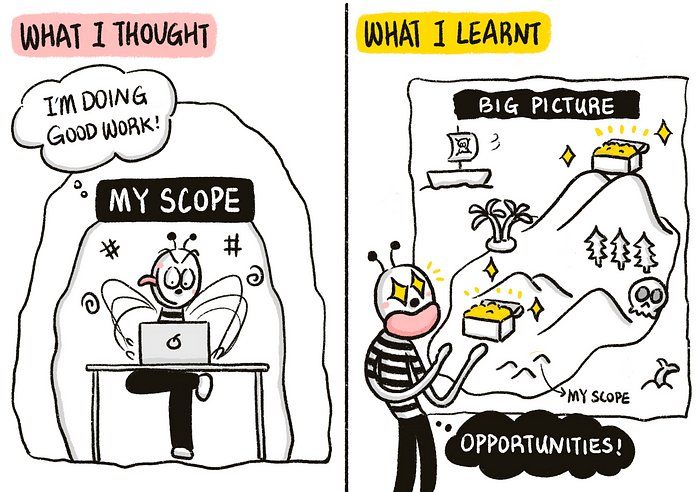
Today, as I mentor Junior designers, to help them think more like an owner, I like to ask them,
What would you do if you were in charge - if you were your manager, product manager, or even better, the CEO? "
How would you answer that question for your job?
The mindset shift from an executor to an owner will make a big difference in how you think about your job and how you act.
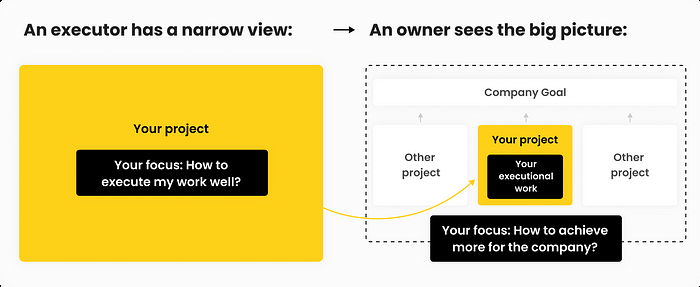
When you receive a project, if you think like an executor, you may ask:
- What are the project requirements?
- What does the PM mean when they say xyz?
- What do I expect for this project?
These are all legitimate questions to ask, but they rarely lead to identifying bigger opportunities. They focus on instructions and understanding others' opinions.
If you think like an owner, your questions will become:
- What are the project goals? How do they connect to the company's ultimate goals? Are these good goals?
- Is this project the most impactful thing for the team right now? Are there other impactful projects?
- What does success look like? What needs to happen for this project to succeed? What are the risks? Is there a better approach?
- How can I and everyone else in the team contribute the most?
Can you answer these questions?
Someone may have given you some answers, but still, take the time to think. Make sure you truly understand the reasons behind the decisions. That's how you can train your strategic thinking muscle. If there are questions you can't answer, that's a great learning opportunity. Ask someone for their opinion, and then form your own opinion. Learn from others, but think seriously about what they say before accepting their answer as truth.
What will happen if you think through and voice different opinions from others? Are you wrong? Probably not! Speak more in the next section.
3: Voice opinions even when you're not 100% sure.
It can be scary to voice initial opinions, especially if your opinion differs from others. You may worry about being wrong.
But let me tell you a clear secret: there is no right or wrong answer in design and product development. Teams can achieve similar results in different ways. Everyone, even senior Viking people, is just making their best guesses based on past experiences. Your opinion may differ, but that doesn't mean you're wrong.
It took me a while to internalize this lesson. When I started at Google, I remember watching lead designers walk around me from meeting to meeting, with their heads and laptops under their arms, talking very confidently and sometimes aggressively. "Wow! They know what they're doing!" I thought in my mind. I thought they had all the answers and I hoped to become like them one day!
Finally, when I became part of a leadership team, I began to see everything differently. I led my first large-scale project in my second year at Meta. I worked with 3 other designers. While I wasn't explicitly called a design leader, I was one of the more experienced and hired designers. So, I felt responsible for the overall project. So, before realizing it, I started leading on this issue - I continued to suggest what we should do next, do more user research, do a weekly design critique
And, people listened and followed my suggestions, not just once, but multiple times, which at that time, as a new leader, was surprising.
In my mind, I still wasn't sure about the suggestions I put out there. But it seemed like others thought I knew what I was doing and they followed what I proposed?! That made me wonder, does that mean, all the great leaders of Islam that I once sought aren't 100% sure?
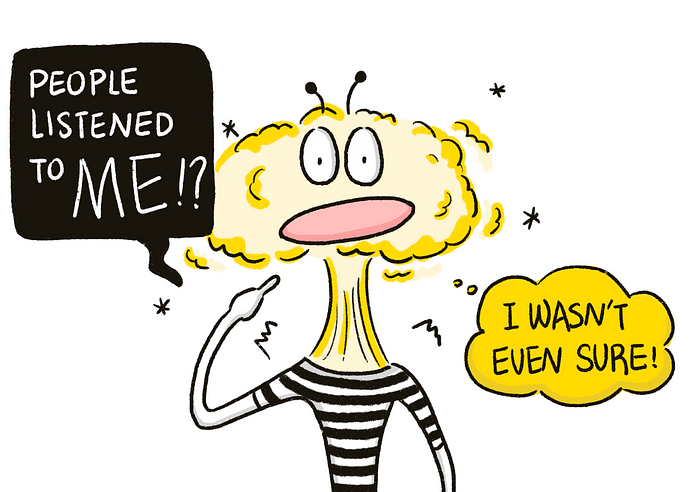
Fast forward to now, I've learned that no one is sure 100%. The senior leaders of the Vikings have more experience, so they are more confident in making educated guesses. But they are still guessing, after all, there is no right answer.
Speaking of the right answer, recently advising a designer, she asked me what to do next for her projects. As consultants often do, I asked for her thoughts first. She shared her thoughts and then said,
"Now, you can give me the right answer!"
"The right answer?! Do you think I asked for your opinion just so I can tell you that you're wrong?! That makes sense!" I thought in my mind.
I also once sought the Viking's answers from the great leaders of Islam. But now, as the tables turn, I see that the great leaders of Islam are not teachers. There are no textbook answers. The senior leaders of the Vikings don't wait there to say Got Gotcha! You're Wrooong!"
Why not?! There are many different ways to solve a problem. Building products is all about gathering many different perspectives and the incomplete answers of the Vikings to achieve the best possible outcome.
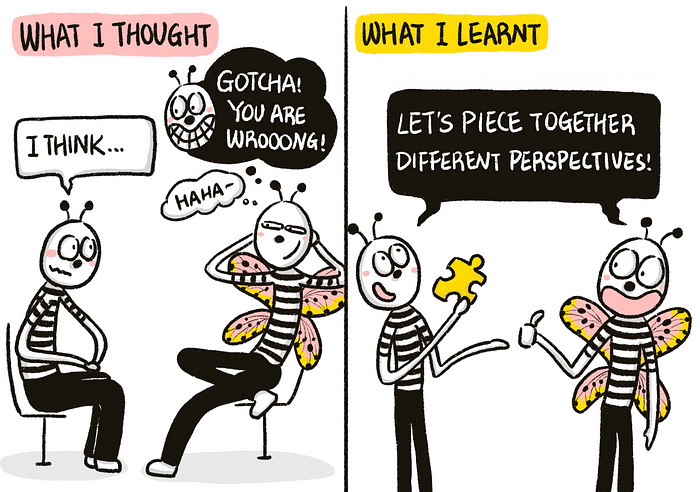
As a base designer, you may have less experience but that doesn't mean your opinion is invalid. In fact, often base designers are the ones who have spent the most time with all the product details. You have a unique perspective, which will help the team create a more comprehensive view of the issue and solution.
And, you don't have to wait until you're 100% sure to share your opinion. If you wait for that, it will never come.
4: When challenged, be determined to understand, not win.
If you've followed all the points before - taken the time to form an opinion, come up with new ideas, and share with your team. It feels great to get recognition, doesn't it? But what if you face pushback and skepticism instead? What if others tell you, I don't get it, then it won't work, then it's too much effort to build
What do you do when people don't agree with you?
When I was a base designer, my instinct was to feel disappointed and defeated internally. But on the surface, I would quickly compromise and agree with others.
As I developed into a more senior designer, I thought I shouldn't agree with others all the time. That would make me look weak! I think being more senior means being strong, defending my opinions, and delivering projects regardless of challenges and disagreements.
So, the first time I led a large-scale project, I was determined to do just that - make everyone agree with me and deliver despite challenges. It was my second year at Meta, and the project involved building connections between multiple teams. As a design leader, I experienced a range of feedback, from team members not seeing any value in the project, to partner teams not interested in collaboration, to engineers unwilling to fix node arrangements.
Despite the pushback, I was determined to build my design vision. In fact, determined to a fault. When people questioned the project and design, I created numerous documents, slides, and prototypes and conducted many 1:1s to make others agree. I was like a samurai loyal to my vision and project, ready to defend, fight, and overcome at any cost.
Throughout the six-month project, I felt like banging my head against the wall. I remember many times sitting on the office carpet at home, thinking, Why can't they agree with me?! Why can't they see what I see?! Why do I have to explain multiple times?! It's frustrating but I think disappointment is a necessary part of leadership. I need to make others agree!
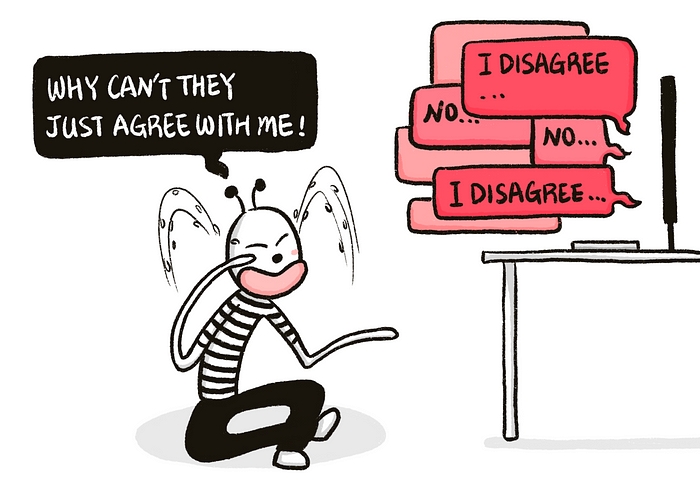
Finally, we delivered the project. But at what cost? I was burnt out and left the team. The product we built was also disappointing, short-lived.
Only then did I realize that I wasn't a leader, I was trying to win, seen as a leader of Islam, and prove that my designs were good and right. I went from one extreme to the other - from someone who quickly compromised to someone who refused to adjust.
Fast forward to now, I've learned that becoming a senior is not about strong opinions and making others agree with me. Having strong opinions is good and important, but these opinions should be loosely held. If we go back to the owner's mindset, my goal was never to win, or get everything my way. My goal was to build understanding and achieve the best possible results as a team.
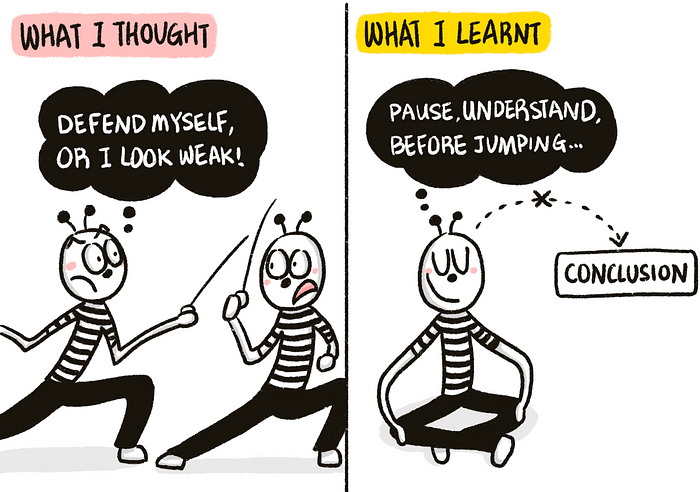
To make it more specific, here's a common scenario:
You've just proposed a new design idea and your engineers immediately push back and say, it can't be done. It's just a designer dreaming up something unrealistic. It will be a waste of time. We don't have engineers to work on it"
To respond, you could:
- Shut down and think, Oh well, that's that. Okay, I won't bring this up again. We can go with another boring solution.
- Or start pushing back immediately, but it would be much better if we do this! We heard in user research that, so this design might meet user needs better and be more engaging and
- Or you could stay calm and try to understand the engineers' perspective more, could you elaborate more on that? How much effort will it take? I think the new designs could help achieve our goal better, do you agree or am I missing something? Help me understand..."
Consider the responses carefully:
- The first response is how I used to default as a base designer - feeling personally attacked and quickly retreating.
- The second response is how I would react when I focused on seeking out the strong and immediate, so I would fight to win.
- The third response is what I aim for if faced with the situation now - pause, ask more questions, and respond after I understand others' points. Then, try to build opinions and achieve better results together.
If after hearing what the engineers say, you agree with them and abandon your idea, will you look weak? No, in fact, if you can set aside the ego and adjust your opinion, that will be a strength.
Staying calm when challenged is not easy. It requires not taking everything personally and reminding yourself that there is no right or wrong answer (remember?). Everyone has different opinions - build on them, rather than trying to prove that your opinions are the right ones. A true leader is someone focused on understanding and arriving at the best possible solutions as a team, rather than winning.
5: Fear and doubt will always be there, but don't let them stop you.
Growth means doing something new, which naturally, involves fear and doubt. As you continue on the journey to becoming a senior designer, sometimes you will certainly feel uncertain - worrying about saying the wrong things, making mistakes, or others disagreeing with you. It's all expected and part of growth.
I used to think that as I developed as a designer and as a person, I would become wiser, more confident, and less fearful. But what I've learned is that sometimes fear and doubt come back even stronger. Why? Because I'm seeking out bigger challenges.
Last year, I spoke at 6 international design conferences. The audience ranged from 600 to 2,000 people. Was I afraid to speak in front of 2,000 people? Of course! I was very afraid that in the days leading up to my talk, I wanted to run away so badly. I regretted saying yes to the speaking engagements. I worried that my opinions wouldn't be worth people's time. I worried that I would forget my words and freeze on stage. I worried that my jokes would sound awkward and silly...
But then, every time, I did my best to prepare for my talks, pack as much value as possible, and present as confidently as I could. And every time, after the talks, some audience members would tell me they found value in my talks. Phew ~ so I did it again and signed up for more conference speaking engagements. Wrote more articles. Sought out bigger challenges. Felt my fear but pushed through anyway. Grew with each attempt.
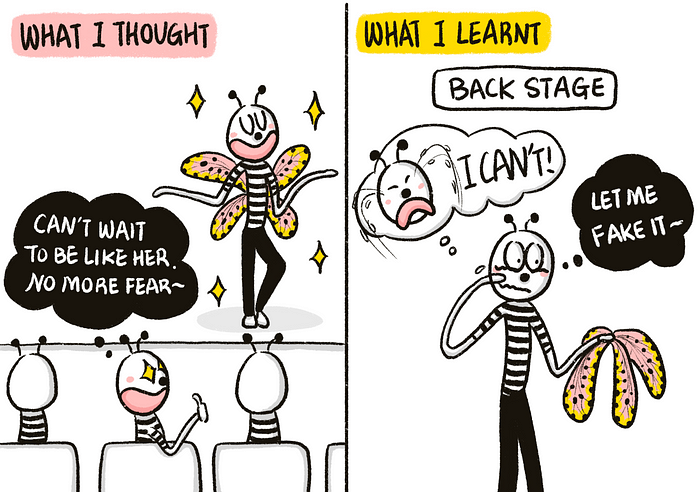
Looking back on seven years as a designer, I've grown and changed - no longer the quiet junior designer, now a more experienced, opinionated, and confident individual. But I know I'm still early on my journey. I have much more that I want to do. And, I have much more fear, doubt, disappointment, shortcomings, and most importantly, growth ahead of me.
For you, my friend, becoming a senior designer will be a significant step, but certainly not an end. You will achieve much more after that. So, my final point here, is to remind you on the journey to becoming a senior designer and beyond: fear and doubt will always be there, but don't let them stop you. Embrace your fear, seek out challenges, make mistakes, learn, and grow in each of your efforts ~
Lessons Learned
What do you think? Are you more excited about your transformation ahead?
In summary, here are 5 mindset shifts to help you feel more prepared for the journey to becoming a senior designer:
- Growth will be initiated. No one can hand it to you.
- To step up, become an owner, not an executor.
- Voice opinions even when you're not 100% sure.
- When challenged, be determined to understand, not win.
- Fear and doubt will always be there, but don't let them stop you.
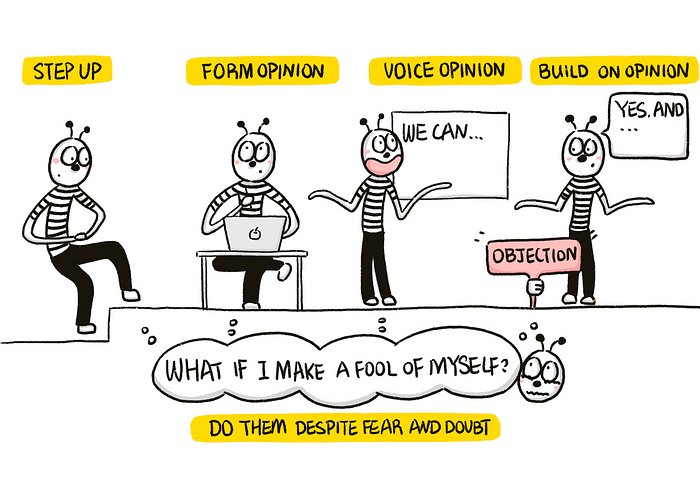
If you still feel unsure, listen to this, then there's nothing in a caterpillar telling you it will be a butterfly. That's a great quote from R. Buckminster Fuller. We all have so much potential within us. The butterflies are there, waiting to emerge.
Growth starts with believing in yourself. Try after try, you'll have your breakthrough. You'll look back and see that you've always had it in you - break out of your cocoon, let the butterfly emerge, spread its wings, and soar!
Rooting for you!

If you can't say, I'm passionate about helping designers grow. If you're interested in chatting, reach out to me at hello@yutongyunan.com or connect with me on LinkedIn.
If you enjoy what I share, join my newsletter from my website to receive more stories, resources, and design insights.
